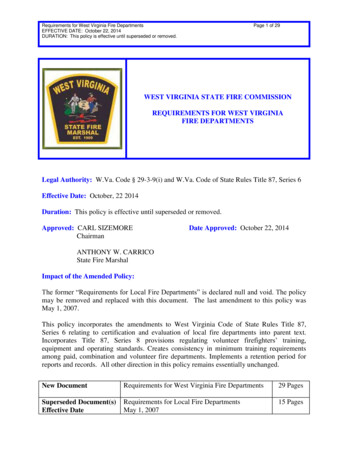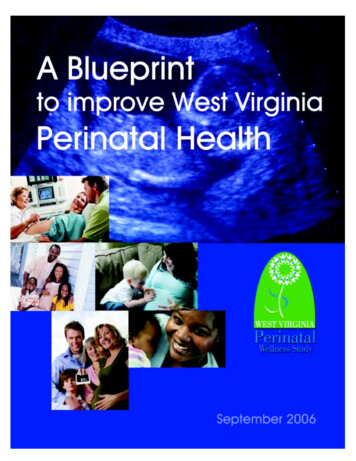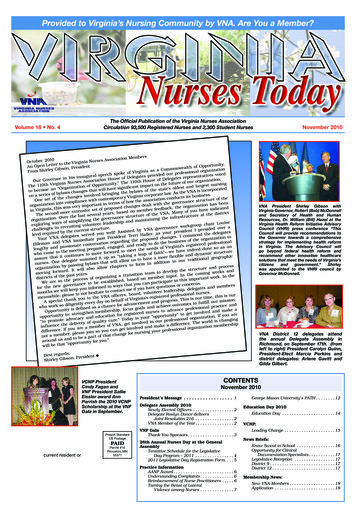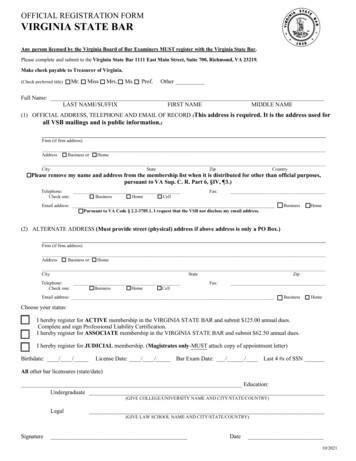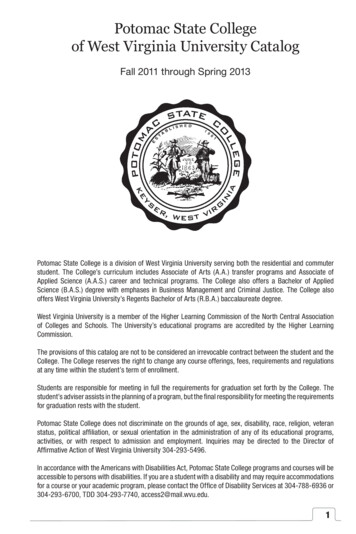
Transcription
West Virginia State Health PlanFinancing and Cost Considerations*I. BACKGROUNDHealth care costs, and the average person’s ability to afford needed care, have been major social concerns fordecades, and there is little likelihood that this will change soon. More than 30 years after the advent of Medicare,and nearly as long since most federal/state Medicaid programs were established, economic barriers to the receiptof health services remain an enduring problem for many families. The numbers of uninsured and underinsuredpersons continue to grow, even in times of relative prosperity. Recent estimates put the number of uninsured atmore than 43 million persons, nearly 16% of the national population. Millions more are in plans or holdingindemnity policies that offer only limited coverage. These numbers are growing at about one million persons ayear because of labor market changes that have resulted in a smaller percentage of workers obtaining healthinsurance as an employment benefit.National experience in recent years illustrates the nature of the problem and the difficulty of addressing it directly.Aside from a comparatively mild recession in the early 1990s, the national economy has been unusually strongover the last decade. Following the brief economic downturn in 1991-92, momentum appeared to be buildingtoward fundamental changes in the way health care is organized, financed, and delivered. When health carereform failed in 1994, and the national economy improved, the near-term prospect of large scale changesevaporated. Attention shifted to smaller, incremental changes at the state and local levels and to market changes,especially in the form of managed care organization, delivery, and payment. Central concerns appear to haveshifted from universal coverage and access to the prospect of increased efficiency and cost control. If history isa guide, interest in larger scale approaches to improving the financing and affordability of health care are likelyto await either the return of more difficult economic times that threaten larger numbers of those now reasonablywell insured or a growing dissatisfaction with the excesses of managed care to reach critical mass.Notable changes in the system in recent years have been in the way health care is purchased and delivered ratherthan in the ability to afford it. Responding to rapidly rising health care costs in the 1970s and 1980s, employersbegan restructuring health benefits programs to gain better control over costs. Initial steps taken by many largercompanies were the development of self-insurance schemes to reduce overhead costs and the institution of greateremployee cost sharing and other economic incentives to stimulate cost-consciousness among those insured. Bothprivate and public employers soon moved beyond self-insurance and incremental cost-reduction strategies to abroader, more comprehensive approach through various forms of managed care. Most of these shifts haveoccurred during the last decade, with the rate of change varying considerably among regions and states.Currently, private and public employers alike, as well as those administering the Medicare and Medicaidprograms, are using a number of strategies and techniques to strengthen their purchasing power and increaseeconomic competition among health care providers and managed care plans. Providers and health plans haveresponded to these pressures by developing a variety of new organizational and financing arrangements.*Note: tables and maps referenced but not contained here may be viewed and obtained, in their entirety, as the West Virginia Health Care Authority.West Virginia State Health PlanIssue StatementMacQuest Consulting, 1999Page FN - 1
Some of the results so far have included greater vertical and horizontal integration of the delivery system,consolidation of facilities and services, and a substantial increase in the reliance on managed care. The degree ofmanaged care penetration (the proportion of the population enrolled in managed care insurance plans) varieswidely by state and community, but the principles and practices characteristic of most managed care plans arenow endemic.II. SYSTEM ASSESSMENTFinancing and cost control efforts in West Virginia are nearly as distinctive as the state’s geography anddemography. There is an unusually high dependence on public health insurance programs. About 18% of thepopulation are Medicare enrollees and nearly 20% are Medicaid recipients. Approximately 18% are uninsured.Of the total population, only 40% to 45% have private health insurance at any given time. Of those personsunder 65 years of age, i.e., excluding most Medicare-eligible persons, about two-thirds (66%) are covered byprivate health insurance. The majority of those, about 60%, obtain their coverage through their place ofemployment. Both the dependence on public health insurance programs and the uninsured level are higher thanthose of the nation and those of neighboring states (Table AR 1, entries 95-125). Conversely, the level of privateinsurance is lower than that of the nation and of contiguous states.West Virginia has a comparatively low managed care penetration level. Only a handful of managed care plans (7)offer coverage, while only about 12% of the population is insured under managed care plans. State health officialshave undertaken a number of notable initiatives to try to encourage the development of managed care optionsand to otherwise better manage health care resources, control costs, and improve quality. The more substantialefforts are summarized below.A. Medicaid Managed CareFederal policy and regulations allow states to obtain waivers of certain provisions of Medicaid operatingrequirements in order to permit the program to be tailored to the needs of the state and the populations to beserved. Most waivers are sought to permit states to develop some form of managed care for some or all of itsMedicaid-eligible population. Section 1115 waivers (Section 1115 of the Social Security Act) usually arerequested to expand Medicaid program eligibility and coverage to low-income persons that federal rules do notrequire to be covered. Waivers vary considerably from state to state, and multiple waivers can be obtained by astate. Most of the Section 1115 waivers requested are sought to implement managed care plans tailored to theneeds of the applicant state. Fifteen states now have Section 1115 waivers in effect, some of them statewide, andnine others have applications pending. West Virginia has not sought a waiver to expand or extend Medicaidprogram coverage under Section 1115.West Virginia has obtained 1915(b) and 1915(c) waivers (Sections 1915[b] and 1915[c] of the Social SecurityAct) to permit it to institute case management for Medicaid enrollees statewide, to establish a risk-based managedcare program for a 15-county area, and to offer alternative home and community-based services for selectedmentally retarded, developmentally disabled, and aged and disabled enrollees. These waivers have been in effectsince 1993. The Section 1915(b) waivers are in force, but have encountered difficulty in terms of the availabilityof managed care plans with which to contract and with physician participation. The Section 1915(c) waiverappears to be working well, serving more than 5,000 persons annually at costs far below those that would beincurred if the recipients were required to obtain institutional care.West Virginia State Health PlanIssue StatementMacQuest Consulting, 1999Page FN - 2
1. Mountain Health Trust (MHT)The West Virginia Bureau of Medical Services (BMS), the state Medicaid program, initiated its risk-basedmanaged care plan, Mountain Health Trust (MHT) in 1996. More than 45,000 Medicaid enrollees in 12 of the15 counties included in the waiver (four centered around Charleston in the southwest and the 11 northwest tier ofcounties) are enrolled in one of three health maintenance organizations (Carelink Health Plan, Optimum Choice,and Health Plan of the Upper Ohio Valley) with which BMS contracts to provide care. MHT is a typicalMedicaid managed care plan, but it does not include pharmacy, long-term care, behavioral health benefits, ornon-emergency medical transportation services. Plans are under way to implement the program in three countiesnow authorized but yet not active and to expand it to eight additional counties.BMS tries to promote service and system coordination by encouraging and structuring economic incentives forthe managed care contractors to incorporate West Virginia’s local health departments, primary care centers, andsmall rural hospitals in their network service contracts and arrangements. BMS policy favors capitatedrisk-based managed care over its less-structured case management fee-for-service model. In counties whereboth MHT and Physician Assured Access System (PAAS) are available, Medicaid recipients are required to beenrolled in MHT.2. Physician Assured Access System (PAAS)More than a third of West Virginia’s Medicaid recipients, about 70,000 persons, are enrolled in its primary carecase management program (PCCM) known as PAAS (Physician Assured Access System). Like Mountain HealthTrust, this program also was developed under a 1915(b) waiver granted in 1992, but it is not fully capitated orrisk-based. It is a fee-for-service program that pays physicians a small monthly fee per member to serve as a‘case’ manager for the enrollee. The participating provider serves a ‘gatekeeper’ function by controlling(authorizing) the access of enrollees to certain costly services.PAAS is the only link to the health care system, particularly to physician services, for many of West Virginia’spoor. As envisioned by BMS, primary care case management is intended to: provide the critical link to the health system for enrollees;assure access to care for difficult-to-serve clients;improve continuity of care across service settings, andmanage service delivery more effectively by requiring informed authorization for services and, thereby,reduce inappropriate use of services.PAAS uses a variety of practitioners, including nurse practitioners, as primary care providers. Nevertheless,limited physician participation has been the major obstacle to expanding PAAS enrollment. Only about 500 ofWest Virginia’s more than 3,500 physicians have signed up as participating providers under PAAS. As is oftenthe case elsewhere, the lower-than-desired provider participation levels, largely the product of comparativelylow payment levels and the inherent difficulty of case management, reduce the efficiency and effectiveness of theprogram.3. Children’s Health Insurance Program (CHIP)West Virginia’s Children’s Health Insurance Program (CHIP) plan, submitted under Title XXI of the SocialSecurity Act, was approved in September 1998. The state qualifies for approximately 23 million annually infederal monies under the program, provided it matches the federal grant with approximately 5 million. Like themajority of states, West Virginia’s CHIP program is being implemented through the extension of Medicaidprogram benefits. The plan expands Medicaid coverage in two phases. During phase one, initiated July 1, 1998,West Virginia State Health PlanIssue StatementMacQuest Consulting, 1999Page FN - 3
regular Medicaid coverage is extended to uninsured children ages 1 to 5 years old residing in families with annualincomes of between 133% and 150% of the federal poverty level (FPL). Heretofore, eligibility ended at 133% ofthe FPL. More than half of the projected 700 children eligible for the new coverage were enrolled within the firstfew months of the program. Notably, the outreach effort to locate children eligible for CHIP produced an evenlarger number of uninsured children who qualify for Medicaid coverage at the lower coverage levels (up to 133%FPL). It is also noteworthy that the modest nature of the phase one program required the acceleratedimplementation of phase one to ensure that the state did not forego part of the FY98 funds for which it waseligible.Phase two of the program will expand coverage to children ages 6 through 18 living in families with incomes upto 150% of the poverty level. Children in this age group are now covered only if they reside in families withincomes at or below 100% FPL. It is estimated that about 10,000 uninsured children are eligible for coverageunder phase two. As is true in many states, when fully implemented the Children’s Health Insurance Programwill be the most significant step taken in recent years to improve access to care among the state’s poor.All of these initiatives are ongoing and enjoying a measure of success.III. PROBLEM STATEMENTWest Virginia faces unusually difficult health financing and access problems. The population is comparativelyold and aging more rapidly than the nation and neighboring states. Nearly all health measures are more negativethan those found nationally or in nearby states. These circumstances are compounded by the relatively lowsocioeconomic status of the population and the distribution of two-thirds of it over a large, rugged rurallandscape. These conditions are found generally statewide; nearly all counties have indices that compareunfavorably with those found nationally and in nearby states (Maps AC-1 through AC-22).There is a marked dependence upon public insurance plans, largely Medicaid and Medicaid, and a comparativelylarge percentage of the population is uninsured. Thus, a relatively small proportion of the population has privatehealth insurance. These circumstances limit severely the options available to health officials to take steps thatmay be desirable, both to stabilize the system and to restructure it.Health care officials will need to marshal systematically all of the resources available and ensure that they areused as effectively as possible if significant progress is to be made.IV. ANALYSISA. Appropriate Use of Services1. Acute Care Community HospitalsEnsuring the appropriate use of services is one of the more effective ways of controlling costs while improvingboth quality and access to care. Although the state has a comparatively low physician-to-population ratio (TableAR-1, entries 126-153) and unusually high morbidity and mortality levels, there are indications that the use ofinpatient health care services in West Virginia may be higher than is appropriate. Acute care community hospitallocations and comparative hospital use rates for 1994 and 1997 by county are shown on Maps AC-23 and AC-24.In recent years West Virginians have generated about 150 discharges and between 800 and 900 days of inpatientWest Virginia State Health PlanIssue StatementMacQuest Consulting, 1999Page FN - 4
care per 1,000 persons in acute care community hospitals. The average length of hospital stays is also higherthan the national average and those of most nearby states. Admissions, patient days, and the average length of ahospital stay have fallen by roughly 15% to 20% (depending on the point of reference and the array of inpatientservices included in the counts) since peaking in 1994. Nevertheless, current use levels remain considerablyhigher than national rates and those in most nearby states (Table AR-1, entries 80-94).2. Surgical ServicesSurgical data show a similar pattern. As with inpatient care generally, overall surgical rates are higher than thosefound nationally and in contiguous states (Table AR-1, entries 80-94). As in most other states and nationally,total surgical demand has increased modestly (about 2%) since 1994, and there has been a marked shift frominpatient to outpatient surgery. Inpatient hospital surgery volume in West Virginia decreased by 23% between1993 and 1997, and outpatient demand increased by 25%. The proportion of hospital surgery that is done on anoutpatient basis rose from 51% to more than 63%. This shift is consistent with national trends, and given thatthe proportion of surgery undertaken in licensed surgery facilities that is outpatient averages more than 75% inmany communities in nearby states, is likely to continue for some time. This shift also points to the crucial roleambulatory surgery plays, and will continue to play, in the viability of essential community hospitals. Thesystem is highly vulnerable to being undercut by the development of proprietary free-standing surgery facilitiesthat drain away patients and revenue.Other indications of the potential over use of services come from summary state Medicare patient profiles. Thesedata show, among other things, that in 1996 (the most recent year for which comparable data are available)overall surgery rates for West Virginia Medicare patients were about 15% higher than for all Medicare recipients,and higher than the rate in all contiguous states. Notably, West Virginia Medicare patients also had: the second highest hospital discharge (admission) rate for the seven surveillance diagnostic groups; unusually high coronary bypass (CABG) and carotid artery surgery rates; the highest rate of emergency room visits for the top surveillance diagnostic groups; unusually high sex- and age-adjusted in-hospital mortality rates following hysterectomy, cholecystectomy(gall bladder surgery), and prostate surgery, andaverage hospital readmission rates at two days, but much higher-than-average readmission rates at 30days (readmitted within two to 30 days of discharge) for patients with acute myocardial infarction (heartattack), congestive heart failure, chronic obstructive pulmonary disease, and pneumonia. It is unclear how much of these high use levels reflect genuine, unavoidable inpatient and surgical needs that flowfrom an older, more debilitated population. The divergence is so great and consistent, however, that it raises anumber of questions that need to be examined carefully. The answers have significant cost, access, and qualityimplications. Analyses of these patterns for all hospital discharges would be instructive.3. Long-Term Nursing CareExpenditures for long-term nursing care (nursing home) services have constituted the fastest rising part of stateMedicaid budgets for a number of years. The demand for nursing home care is highly elastic, and a number ofstates, including West Virginia, have imposed moratoria on the development of nursing homes. The WestVirginia moratorium has been in effect for more than a decade. The major exception to the moratorium has beento permit small hospitals to convert some of their unused acute care beds to Medicare-certified skilled care use.About 10% of the state’s licensed nursing home beds (1,033 of 10,791 beds) are located in acute care communityhospitals.West Virginia State Health PlanIssue StatementMacQuest Consulting, 1999Page FN - 5
The moratorium appears to have had a substantial effect. Unlike inpatient hospital use and surgical demand, thestate’s nursing home use rate is lower than the national rate and that of all contiguous states (Table AR-1, entries80-94). Nursing home locations, population density, the percentage of the population 65 years of age and older,and age-specific nursing home use rates by age group and by county of facility are shown on Maps AC-21, AC22, and AC-25 through AC-27. They show comparatively low use levels, lower for example than roughlycomparable Appalachian areas of western and southwestern Virginia, and high occupancy levels (94-95%). Thisis extraordinary, given the state’s population profile, its geography and demography, and the evidence ofunusually high levels of chronic and disabling conditions across the state. Although there are a number ofpersonal care homes (a total of 3,095 licensed beds) and home health services around the state, there appear to befewer alternatives to nursing home care than found in many nearby states. Nursing home use rates and levelsprobably are helping to control Medicaid program expenditures, but they do raise questions about access andequity for patients and providers of care alike that warrant careful examination.B. Cost and ChargesThe unusually high dependence on public health insurance programs is a mixed blessing for the state’s healthcare providers and for the health care system in general. As noted earlier, a majority of the population (about56%) is either insured by Medicare and/or Medicaid or is uninsured. Only a minority (40% to 45%) have privatehealth insurance. Public payments are relatively stable and absolutely essential to the well-being of the state’shealth care system. Including public employees (PEIA), more than 70% of all hospital discharges are covered bygovernment payment plans. Only about 30% of hospital revenues come from nongovernmental sources.Similarly, more than 77% of those who use primary care centers statewide are either insured by governmentprograms or have no insurance. Less than 23% are insured privately. Community hospitals and the primary carecenters are the two largest providers of charity care in the state. Their ability to do so is heavily dependent on notonly the private monies they receive for services but also on the public monies that defray substantial overheadcosts. The pattern is even more pronounced with nursing homes, where the vast majority are enrolled in theMedicaid or Medicare program. Data for free-standing ambulatory surgery centers are not available, but it islikely that the majority of patients are either privately insured or are Medicare enrollees.Dependence on federal programs and monies is particularly strong. Medicare patients and revenues alone accountfor nearly half (48%) of all hospital volume and receipts and for nearly 40% of primary care center volumestatewide. Because about three out of four Medicaid dollars are federal matching monies, a substantial majority(60% to 65%) of health system revenues in the state are directly or indirectly federal. Community hospitaldependence on Medicare monies will increase somewhat as more are designated critical access hospitals, makingthem eligible for cost-based reimbursement.High unavoidable dependence on public insurance programs, particularly the Medicare program, suggests that itwould be prudent to develop strategies to maximize the ability of health care providers, services, and facilitiesstatewide to qualify as Medicare providers (cost-based where possible) and to ensure that those who may qualifyfor eligibility enroll as early as possible.C. Managed CareAs might be expected in a comparatively poor rural state, there is very little commercial managed care in WestVirginia. As noted earlier, state health officials have made a concerted effort to encourage the development ofplans and have established statewide case management (PAAS) and a capitated managed care plan (MHT) forsome Medicaid recipients. A total of about 200,000 persons, about 12% of the population, are now enrolled inWest Virginia State Health PlanIssue StatementMacQuest Consulting, 1999Page FN - 6
one of the seven plans that serve the state. Managed care enrollment in the state will probably continue to grow,but very gradually. Given the problems being experienced elsewhere with managed care in more attractivemarkets, and the recent widespread disenrollment of Medicare recipients by a number of plans nationwide, it isdifficult to see where or how growth is likely to accelerate any time soon.It is noteworthy that many, if not all, of the positive market changes many associate with managed care, i.e., loweruse rates, substitution of less expensive outpatient care for inpatient care where possible, reduction in capitalspending for unnecessary facilities and equipment, are not necessarily dependent on high managed carepenetration levels. Progress in reducing unnecessary inpatient use, the continued shift from outpatient surgery toinpatient surgery where possible, and the introduction of more efficient operations and practices are likely tocontinue apace, even if managed care levels do not rise. Market examples and economic forces generally willhave effects, both positive and negative, regardless of how intensely or directly they are applied locally.V. ACTION STEPSSeveral steps that might be taken to ameliorate, if not resolve, some of the economic difficulties faced by the WestVirginia health care system are outlined below. Assess the relative cost and charge structures of proprietary facilities and services compared with thoseof not-for-profit facilities and services. A significant number of West Virginia’s hospitals and surgeryfacilities are proprietary. Proprietary facilities elsewhere tend to have higher charges and to serve alarger percentage of the privately insured population. In some cases, this decreases both patients andrevenues to essential community services and facilities, driving up both aggregate and unit costsunnecessary. Assessment findings should be used in policy formulation and in certificate of need andlicensing decisions.Given the heavy, and growing, dependence of community hospitals on outpatient surgery patients andrevenue for long-term survival, the role and effects of proprietary free-standing surgery centers on localhealth care systems warrant study. Efforts should be made to ensure that the ‘profits’ made fromambulatory surgery are not lost to the system as a whole. Complete the small area analysis and managed care market profile studies discussed elsewhere (see AtRisk and Coordinated System statements). These studies would be modeled, respectively, along the linesof the profiles in the Dartmouth Atlas of Health Care and the Milliman and Robertson Health CareManagement Guidelines. Map AC-23 shows the locations of West Virginia hospitals and suggestedservice areas boundaries for both initial studies. Review the history and results of Section 1115 Medicaid waivers in other states to determine whetherthis option is economically and politically viable in West Virginia. Given the unusually favorablefederal/state match rate available, the high percentage of the population uninsured, the economicvulnerability of the small rural hospitals, local health departments, and primary care centers, and theearly experience of the children’s health insurance initiative, this approach appears to have promise,providing the necessary matching monies can be found or offset with funds from other sources. Ensure that any expansion of managed care incorporates a feature that strongly encourages managedcare plans to include local health departments, primary care centers, and small community hospitals intheir networks providing care. This feature is especially important given the current and potentialmigration of West Virginia residents to neighboring states for care.West Virginia State Health PlanIssue StatementMacQuest Consulting, 1999Page FN - 7
VI. POTENTIAL SOLUTIONSGiven the extraordinary reliance on public payment programs, health care officials need to take steps to ensurethe state and its citizens receive all the health and health-related federal support for which they can qualify. Theimportance of the assistance and the magnitude of the effort are such that the function may need to be givenspecial status and priority by assigning it to a specific entity or office with the authority and capability ofcoordinating effectively all such efforts statewide and of integrating them effectively with efforts to obtainprivate grant and foundation monies.Hospital, local health department, and primary care center budgets, costs, and operating returns (‘profits’ orbudget balances) vary widely across the state. In the absence of full system integration, means and methodsshould be sought to provide incentives for those not-for-profit entities with relatively high operating returnsand/or budgets to directly or indirectly support related entities that may be threatened.VII. POLICY RECOMMENDATIONSConsideration should be given to developing a regulatory framework that would encourage the expansion ofmanaged care principles, where feasible, through the formation of provider-sponsored organizations and networksas specially designed, risk-bearing managed care plans, provided public interest operating requirements (e.g.,community rating vs. experience rating) can be satisfied. The review of state health laws and regulations nowunder way as part of the Turning Point project (discussed in Public Health statement) may be helpful in thisregard.Consideration should be given to modifying the certificate of need program (discussed in the Access statement) torefine the current moratorium on nursing home development and incorporate a managed competition feature suchas prospective population-based planning combined with a request for proposals/applications process.Consider amending the certificate of need program to require that all features of the program, i.e., review andapproval, and follow-up data reporting, apply to all licensed surgery centers.Consider amending the certificate of need program to provide for an administrative review process that wouldexpedite review and approval of projects and proposals that are consistent with the published state health plan orare in response to a request for proposal issued by the planning authority.Make efficient and effective use of new tobacco settlement and tax revenues to support health and health-relatedprojects, particularly those associated with cessation of tobacco use educational efforts and the maintenance of asystem of care for those with tobacco-related diseases and conditions. Additional taxes on products that havesubstantial negative health effects, e.g., tobacco and alcohol, might be considered, both to discourage the use ofthose products and to obtain funds to support health services needed to treat the diseases generated by their use.Given the very favorable federal/state match enjoyed by West Virginia, consideration should be given toexpanding both CHIP and Medicaid generally through Section 1115 waivers.Consideration should be given the formation of statewide high risk insur
than in the ability to afford it. Responding to rapidly rising health care costs in the 1970s and 1980s, employers began restructuring health benefits programs to gain better control over costs. Initial step s taken by many larger companies were the development of self -insurance schemes to reduce overhead costs and the institution of greater


